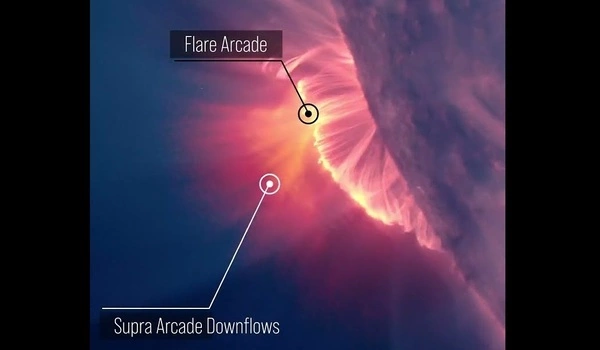The Sun’s surface is a hive of activity. It contains electrically charged gases that produce zones of strong magnetic fields. These are known as magnetic fields. The Sun’s gases are continually moving, causing the magnetic fields to coil, stretch, and twist. This velocity causes a lot of activity on the Sun’s surface, which is known as solar activity.
The Sun’s surface can become extremely active at times. At times, things are a little quieter. The quantity of solar activity changes as the solar cycle progresses. Because solar activity can have an impact on Earth, scientists actively watch it every day.
Astronomers have proposed a new theory to explain the enigmatic downward-moving dark gaps observed in some solar flares. Scientists noticed strange motions within a solar flare in January 1999.
Solar flares are massive explosions on the sun that release energy, light, and fast particles into space. These flares are frequently connected with coronal mass ejections, which are solar magnetic storms (CMEs). The number of solar flares grows every 11 years, and the sun is currently approaching another solar maximum, which will most likely occur in 2013. That means more flares, some small and some large enough to spew radiation all the way to Earth.
What happens on the Sun is that there are numerous magnetic fields pointing in various directions. The magnetic fields are eventually pushed together to the point where they rearrange and unleash a large amount of energy in the form of a solar flare.
Kathy Reeves
Unlike most flares, which show dazzling energy exploding from the Sun, this solar flare also showed a downward flow of motion, as if material was falling back towards the Sun. Astronomers were perplexed by what they saw, which they described as “downward-moving dark voids.”
Astronomers from the Center for Astrophysics | Harvard & Smithsonian (CfA) give a novel explanation for the poorly understood downflows, now known as supra-arcade downflows (SADs) by the scientific community, in a paper published today in Nature Astronomy.
“We wanted to know how these formations happen,” explains lead author and CfA astronomer Chengcai Shen, who refers to the structures as “dark finger-like features.” “What motivates them, and are they actually associated with magnetic reconnection?”
Since their discovery in the 1990s, scientists have assumed that SADs are associated with magnetic reconnection. When magnetic fields break, they emit fast-moving and extremely intense radiation before reforming.

“What happens on the Sun is that there are numerous magnetic fields pointing in various directions. The magnetic fields are eventually pushed together to the point where they rearrange and unleash a large amount of energy in the form of a solar flare” Kathy Reeves, a CfA astronomer and study co-author, adds
Reeves continues, “It’s similar to stretching out a rubber band and severing it in the center. Because it is pressured and stretched thin, it will snap back.”
The black downflows were thought to be the result of shattered magnetic fields “snapping back” to the Sun following a solar flare explosion. But there was a snag.
According to co-author Bin Chen, an astronomer at the New Jersey Institute of Technology, most of the downflows detected by scientists are “puzzlingly slow.” Shen elaborates, “This is not expected by standard reconnection models, which predict significantly faster downflows. It’s a contradiction that necessitates further explanation.”
To figure out what was going on, the researchers examined downflow photos acquired by NASA’s Solar Dynamics Observatory’s Atmospheric Imaging Assembly (AIA). The AIA, which was designed and developed in part at the CfA and is led by the Lockheed Martin Solar Astrophysics Laboratory, takes photographs of the Sun every twelve seconds in seven different wavelengths of light to study variations in the Sun’s atmosphere.
The researchers then created 3D simulations of solar flares and compared them to the observations. The findings indicate that most SADs are not caused by magnetic reconnection after all. Instead, they arise on their own in a turbulent environment as a result of the interaction of two fluids with different densities.
According to Reeves, scientists are observing the same thing that happens when water and oil are mixed together: the two differing fluid densities are unstable and eventually separate. “Those dark, finger-like holes are caused by a lack of plasma. The density is significantly lower than in the surrounding plasma” According to Reeves.
To better understand magnetic reconnection, the team intends to continue studying SADs and other solar phenomena using 3D models. Understanding the processes that cause solar flares and eruptions from the Sun may eventually aid in the development of methods for forecasting and mitigating the effects of space weather.















